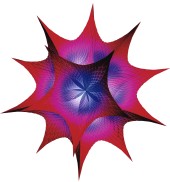Mathematica8
"Following closely on the dramatic reinvention of Mathematica in 2007, Mathematica 7 continues the momentum of innovation to deliver an array of new capabilities, greatly extending the state of the art in many areas, and bringing a dozen major new application fields into the integrated framework of Mathematica."
Kommentar eines Kunden: "Mathematica 7 ist Spitze !!!" G.A.
Gratis online-Seminare zu Mathematica 7
Jetzt neu: Lehrreiche und informative kurze Videos zu Mathematica 7
Neue Eigenschaften (anschauliche Information in den Videos)
Front-End Features
Integration with Wolfram|Alpha
- Type "=" to begin an input cell, then a query, to compute results using Wolfram|Alpha
- The new function
WolframAlpha[]
can programmatically perform the same task
Programmatically evaluate entire notebooks
- Use the new function
NotebookEvaluate[]
to evaluate cells in a specified notebook; see ref/NotebookEvaluate for more information
New citation management functionality
- Citation management supports both EndNote and BibTeX styles
- The new functionality is available in the Mathematica menu under Insert > Citation
Printing and layout improvements
- A new "Headers and Footers" dialog is available under File > Printing Settings > Headers and Footers...
- Improvements include support of self-indexing running heads and many ease-of-use additions
- "Print Preview" is now available on Windows and Linux under File > Print Preview
Improvements to
InputField[]
- Fields now support horizontal scrolling
- Field contents can be hidden using the option
FieldMasked -> True
New Find/Replace dialog
- Finding and replacing content in fully typeset text is now supported
- Highlighting of search results has been enhanced
Under-the-hood 3D renderer enhancements
- Mathematica now uses a "depth-peeling" renderer, which improves performance in graphics that utilize transparency
Kernel Features
Built-in control systems capabilities
- New functions have been streamlined and integrated with all of Mathematica's features
- Both symbolic and numeric calculations are supported
- Control system functionality has been added, expanding that of the Control System Professional package; see built-in documentation starting at guide/ControlSystems
New and enhanced image processing capabilities
- Deconvolution algorithms for image restoration are now included
- Detection of edges and other image feature have been added
- New functionality has been added for segmentation and shape analysis
New formats for
Import/Export
- GIS, microarray, graph, and XLSX formats are now supported
Extensive probability and statistics functionality
- See built-in documentation from the root guide page at guide/ProbabilityAndStatistics
New tools for software development
- C code generation features from the Mathematica compiler improve the speed and flexibility of programs, and are integrated with built-in parallel computation using the Mathematica kernel
- Call C compilers to build DLL files and executables; see DLLTools/tutorial/Overview for more information
- CUDALink and OpenCLLink give access to GPU functionality using CUDA and OpenCL; see CUDALink/guide/CUDALink and OpenCLLink/tutorial/Overview for more information
New numeric and symbolic methods
-
Solve
andNSolve
have new implementations, including solving over different domains; see ref/Solve and ref/NSolve for more information - New
NIntegrate
methods have been added, particularly for oscillatory integrals; see ref/NIntegrate for more information
Weitere Informationen (auf Englisch) finden Sie hier, oder Sie nehmen Kontakt zu uns auf.